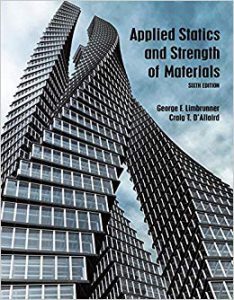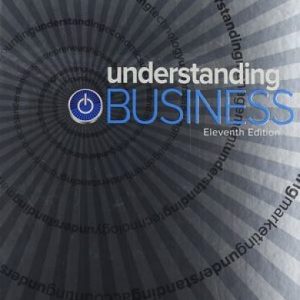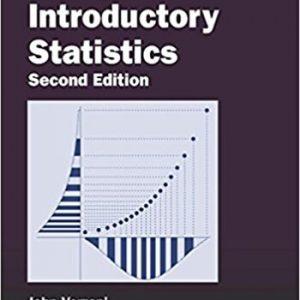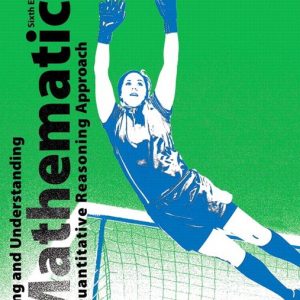This is completed downloadable of Solution Manual for Applied Statics and Strength of Materials (6th Edition) 6th Edition by George F. Limbrunner and Craig D’Allaird.

Instant download Solution Manual for Applied Statics and Strength of Materials (6th Edition) 6th Edition by George F. Limbrunner and Craig D’Allaird pdf docx epub after payment.
Product Details:
ISBN-10 : 0133840549
ISBN-13 : 978-0133840544
Author: George F. Limbrunner; Craig D’Allaird
This resource provides the necessary background in mechanics that is essential in many fields, such as civil, mechanical, construction, architectural, industrial, and manufacturing technologies. The focus is on the fundamentals of material statics and strength and the information is presented using an elementary, analytical, practical approach, without the use of Calculus. To ensure understanding of the concepts, rigorous, comprehensive example problems follow the explanations of theory, and numerous homework problems at the end of each chapter allow for class examples, homework problems, or additional practice for students. Updated and completely reformatted, the Sixth Edition of Applied Statics and Strength of Materialsfeatures color in the illustrations, chapter-opening Learning Objectives highlighting major topics, updated terminology changed to be more consistent with design codes, and the addition of units to all calculations.
applied statics and strength of materials 6th edition answer key
applied statics and strength of materials answers
applied statics and strength of materials
applied statics and strength of materials answers
TABLE OF CONTENT:
- Applied Statics and Strength of Materials
- Applied Statics and Strength of Materials
- Brief Contents
- Contents
- Preface
- Chapter One Introduction
- Learning Objectives
- 1.1 Mechanics Overview
- 1.2 Applications of Statics
- 1.3 The Mathematics of Statics
- 1.3.1 Right Triangles
- 1.3.2 Oblique Triangles
- 1.4 Calculations and Numerical Accuracy
- 1.5 Calculations and Dimensional Analysis
- 1.6 SI Units for Statics and strength of Materials
- Summary By Section Number
- Problems
- Section 1.3 The Mathematics of Statics
- Section 1.5 Calculations and Dimensional Analysis
- Section 1.6 SI Units for Statics and Strength of Materials
- Supplemental Problems
- Chapter Two Principles of Statics
- Learning Objectives
- 2.1 Forces and the Effects of Forces
- 2.2 Characteristics of a Force
- 2.3 Units of a Force
- 2.4 Types and Occurrence of Forces
- 2.5 Scalar and Vector Quantities
- 2.6 The Principle of Transmissibility
- 2.7 Types of Force Systems
- 2.8 Orthogonal Concurrent Forces: Resultants and Components
- Summary By Section Number
- Problems
- Section 2.8 Orthogonal Concurrent Forces: Resultants and Components
- Computer Problems
- Supplemental Problems
- Chapter Three Resultants of Coplanar Force Systems
- Learning Objectives
- 3.1 Resultant of Two Concurrent Forces
- 3.2 Resultant of Three or More Concurrent Forces
- 3.3 Moment of a Force
- 3.4 The Principle of Moments: Varignon’s Theorem
- 3.5 Resultants of Parallel Force Systems
- 3.5.1 Uniformly Distributed Line Loads
- 3.5.2 Nonuniformly Distributed Line Loads
- 3.5.3 Hydrostatic Forces
- 3.6 Couples
- 3.7 Resultants of Nonconcurrent Force Systems
- Summary by Section Number
- Problems
- Section 3.1 Resultant of Two Concurrent Forces
- Section 3.2 Resultant of Three or More Concurrent Forces
- Section 3.3 Moment of a Force
- Section 3.4 The Principle of Moments: Varignon’s Theorem
- Section 3.5 Resultants of Parallel Force Systems
- Section 3.6 Couples
- Section 3.7 Resultants of Nonconcurrent Force Systems
- Computer Problems
- Supplemental Problems
- Chapter Four Equilibrium of Coplanar Force Systems
- Learning Objectives
- 4.1 Introduction
- 4.2 Conditions of Equilibrium
- 4.3 The Free-Body Diagram
- 4.4 Equilibrium of Concurrent Force Systems
- 4.5 Equilibrium of Parallel Force Systems
- 4.6 Equilibrium of Nonconcurrent Force Systems
- Summary by Section Number
- Problems
- Section 4.3 The Free-Body Diagram
- Section 4.4 Equilibrium of Concurrent Force Systems
- Section 4.5 Equilibrium of Parallel Force Systems
- Section 4.6 Equilibrium of Nonconcurrent Force Systems
- Computer Problems
- Supplemental Problems
- Chapter Five Analysis of Structures
- Learning Objectives
- 5.1 Introduction
- 5.2 Trusses
- 5.3 Forces in Members of Trusses
- 5.4 The Method of Joints
- 5.4.1 Summary of Procedure: Method of Joints
- 5.5 The Method of Sections
- 5.5.1 Summary of Procedure: Method of Sections
- 5.6 Analysis of Frames
- Summary by Section Number
- Problems
- Section 5.4 The Method of Joints
- Section 5.5 The Method of Sections
- Section 5.6 Analysis of Frames
- Supplemental Problems
- Chapter Six Friction
- Learning Objectives
- 6.1 Introduction
- 6.2 Friction Theory
- 6.3 Angle of Friction
- 6.4 Friction Applications
- 6.5 Wedges
- 6.6 Belt Friction
- 6.7 Square-Threaded Screws
- Summary by Section Number
- Problems
- Section 6.4 Friction Applications
- Section 6.5 Wedges
- Section 6.6 Belt Friction
- Section 6.7 Square-Threaded Screws
- Computer Problems
- Supplemental Problems
- Chapter Seven Centroids and Centers of Gravity
- Learning Objectives
- 7.1 Introduction
- 7.2 Center of Gravity
- 7.2.1 Summary of Procedure: Center of Gravity of Built-Up Members
- 7.3 Centroids and Centroidal Axes
- 7.4 Centroids and Centroidal Axes of Composite Areas
- 7.4.1 Summary of Procedure: Centroids of Areas
- Summary by Section Number
- Problems
- Section 7.2 Center of Gravity
- Section 7.4 Centroids and Centroidal Axes of Composite Areas
- Computer Problems
- Supplemental Problems
- Chapter Eight Area Moments of Inertia
- Learning Objectives
- 8.1 Introduction and Definitions
- 8.2 Moment of Inertia
- 8.3 The Transfer Formula
- 8.4 Moment of Inertia of Composite Areas
- 8.5 Radius of Gyration
- 8.6 Polar Moment of Inertia
- Summary by Section Number
- Problems
- Section 8.2 Moment of Inertia
- Section 8.4 Moment of Inertia of Composite Areas
- Section 8.5 Radius of Gyration
- Section 8.6 Polar Moment of Inertia
- Computer Problems
- Supplemental Problems
- Chapter Nine Stresses and Strains
- Learning Objectives
- 9.1 Introduction
- 9.2 Tensile and Compressive Stresses
- 9.3 Shear Stresses
- 9.4 Tensile and Compressive Strain and Deformation
- 9.5 Shear Strain
- 9.6 The Relation Between Stress and Strain (Hooke’s Law)
- Summary by Section Number
- Problems
- Section 9.2 Tensile and Compressive Stresses
- Section 9.3 Shear Stresses
- Section 9.4 Tensile and Compressive Strain and Deformation
- Section 9.6 The Relation Between Stress and Strain (Hooke’s Law)
- Computer Problems
- Supplemental Problems
- Chapter Ten Properties of Materials
- Learning Objectives
- 10.1 The Tension Test
- 10.2 The Stress–Strain Diagram
- 10.3 Mechanical Properties of Materials
- 10.4 Engineering Materials: Metals
- 10.4.1 Ferrous Metals
- 10.4.2 Cast Iron
- Gray Cast Iron
- White Cast Iron
- Ductile Iron
- Malleable Iron
- 10.4.3 Steel
- Carbon Steel
- Alloy Steel
- Stainless Steel
- Structural Steel
- 10.4.4 Nonferrous Metals
- Aluminum
- Titanium
- Copper and Copper Alloys
- 10.5 Engineering Materials: Nonmetals
- 10.5.1 Concrete
- 10.5.2 Wood
- 10.5.3 Plastics
- 10.6 Allowable Stresses and Calculated Stresses
- 10.7 Factor of Safety
- 10.8 Elastic–Inelastic Behavior
- Summary by Section Number
- Problems
- Section 10.2 The Stress–Strain Diagram
- Section 10.6 Allowable Stresses and Calculated Stresses
- Section 10.7 Factor of Safety
- Section 10.8 Elastic–Inelastic Behavior
- Computer Problems
- Supplemental Problems
- Chapter Eleven Stress Considerations
- Learning Objectives
- 11.1 Poisson’s Ratio
- 11.2 Thermal Effects
- 11.3 Members Composed of Two or More Components
- 11.4 Stress Concentration
- 11.5 Stresses on Inclined Planes
- 11.6 Shear Stresses on Mutually Perpendicular Planes
- 11.7 Tension and Compression Caused By Shear
- Summary by Section Number
- Problems
- Section 11.1 Poisson’s Ratio
- Section 11.2 Thermal Effects
- Section 11.3 Members Composed of Two or More Components
- Section 11.4 Stress Concentration
- Section 11.5 Stresses on Inclined Planes
- Section 11.7 Tension and Compression Caused by Shear
- Computer Problems
- Supplemental Problems
- Chapter Twelve Torsion in Circular Sections
- Learning Objectives
- 12.1 Introduction
- 12.2 Members in Torsion
- 12.3 Torsional Shear Stress
- 12.4 Angle of Twist
- 12.5 Transmission of Power by a Shaft
- Summary by Section Number
- Problems
- Section 12.2 Members in Torsion
- Section 12.3 Torsional Shear Stress
- Section 12.4 Angle of Twist
- Section 12.5 Transmission of Power by a Shaft
- Computer Problems
- Supplemental Problems
- Chapter Thirteen Shear and Bending Moment in Beams
- Learning Objectives
- 13.1 Types of Beams and Supports
- 13.2 Types of Loads on Beams
- 13.3 Beam Reactions
- 13.4 Shear Force and Bending Moment
- 13.5 Shear Diagrams
- 13.5.1 Summary of Procedure: Shear Diagram Construction
- 13.6 Moment Diagrams
- 13.6.1 Summary of Procedure: Moment Diagram Construction
- 13.7 Sections of Maximum Moment
- 13.8 Moving Loads
- Summary by Section Number
- Problems
- Section 13.3 Beam Reactions
- Section 13.4 Shear Force and Bending Moment
- Section 13.5 Shear Diagrams
- Section 13.6 Moment Diagrams
- Section 13.7 Sections of Maximum Moment
- Section 13.8 Moving Loads
- Computer Problems
- Supplemental Problems
- Chapter Fourteen Stresses in Beams
- Learning Objectives
- 14.1 Tensile and Compressive Stresses Due to Bending
- 14.2 The Flexure Formula
- 14.3 Computation of Bending Stresses
- 14.4 Shear Stresses
- 14.5 The General Shear Formula
- 14.6 Shear Stresses in Structural Members
- 14.7 Inelastic Bending of Beams
- 14.8 Beam Analysis
- Summary by Section Number
- Problems
- Section 14.3 Computation of Bending Stresses
- Section 14.6 Shear Stresses in Structural Members
- Section 14.7 Inelastic Bending of Beams
- Section 14.8 Beam Analysis
- Computer Problems
- Supplemental Problems
- Chapter Fifteen Deflection of Beams
- Learning Objectives
- 15.1 Reasons for Calculating Beam Deflection
- 15.2 Curvature and Bending Moment
- 15.3 Methods of Calculating Deflection
- 15.4 The Formula Method
- 15.4.1 The Principle of Superposition
- 15.5 The Moment-Area Method
- 15.6 Moment Diagram By Parts
- 15.7 Applications of the Moment-Area Method
- Summary by Section Number
- Problems
- Section 15.2 Curvature and Bending Moment
- Section 15.4 The Formula Method
- Section 15.5 The Moment-Area Method
- Section 15.6 Moment Diagram by Parts
- Section 15.7 Applications of the Moment-Area Method
- Computer Problems
- Supplemental Problems
- Chapter Sixteen Design of Beams
- Learning Objectives
- 16.1 The Design Process
- 16.2 Design of Steel Beams
- 16.3 Design of Timber Beams
- Summary by Section Number
- Problems
- Section 16.2 Design of Steel Beams
- Section 16.3 Design of Timber Beams
- Computer Problems
- Supplemental Problems
- Chapter Seventeen Combined Stresses
- Learning Objectives
- 17.1 Introduction
- 17.2 Biaxial Bending
- 17.3 Combined Axial and Bending Stresses
- 17.4 Eccentrically Loaded Members
- 17.5 Maximum Eccentricity for Zero Tensile Stress
- 17.6 Eccentric Load Not on Centroidal Axis
- 17.7 Combined Normal and Shear Stresses
- 17.8 Mohr’s Circle
- 17.9 Mohr’s Circle: The General State of Stress
- 17.9.1 Brief Summary: Mohr’s Circle for General Stress
- Summary by Section Number
- Problems
- Section 17.2 Biaxial Bending
- Section 17.3 Combined Axial and Bending Stresses
- Section 17.4 Eccentrically Loaded Members
- Section 17.5 Maximum Eccentricity for Zero Tensile Stress
- Section 17.6 Eccentric Load Not on Centroidal Axis
- Section 17.7 Combined Normal and Shear Stresses
- Section 17.8 Mohr’s Circle
- Section 17.9 Mohr’s Circle: The General State of Stress
- Computer Problems
- Supplemental Problems
- Chapter Eighteen Columns
- Learning Objectives
- 18.1 Introduction
- 18.2 Ideal Columns
- 18.3 Effective Length
- 18.4 Real Columns
- 18.5 Allowable Stresses for Columns
- 18.6 Axially Loaded Structural Steel Columns (AISC)
- 18.7 Axially Loaded Steel Machine Parts
- 18.8 Axially Loaded Timber Columns
- Summary by Section Number
- Problems
- Section 18.2 Ideal Columns
- Section 18.4 Real Columns
- Section 18.6 Axially Loaded Structural Steel Columns (AISC)
- Section 18.7 Axially Loaded Steel Machine Parts
- Section 18.8 Axially Loaded Timber Columns
- Computer Problems
- Supplemental Problems
- Chapter Nineteen Connections
- Learning Objectives
- 19.1 Introduction
- 19.2 Bolts and Bolted Connections (AISC)
- 19.3 Modes of Failure of a Bolted Connection
- 19.4 High-Strength Bolted Connections
- 19.4.1 Shear Strength
- 19.4.2 Bearing Strength
- 19.4.3 Tensile Strength
- 19.5 Introduction to Welding
- 19.6 Strength and Behavior of Welded Connections (AISC)
- Summary by Section Number
- Problems
- Section 19.4 High-Strength Bolted Connections
- Section 19.6 Strength and Behavior of Welded Connections (AISC)
- Computer Problems
- Supplemental Problems
- Chapter Twenty Pressure Vessels
- Learning Objectives
- 20.1 Introduction
- 20.2 Stresses in Thin-Walled Pressure Vessels
- 20.3 Joints in Thin-Walled Pressure Vessels
- 20.4 Design and Fabrication Considerations
- Summary by Section Number
- Problems
- Section 20.2 Stresses in Thin-Walled Pressure Vessels
- Section 20.3 Joints in Thin-Walled Pressure Vessels
- Computer Problems
- Supplemental Problems
- Chapter Twenty One Statically Indeterminate Beams
- Learning Objectives
- 21.1 Introduction
- 21.2 Restrained Beams
- 21.3 Propped Cantilever Beams
- 21.4 Fixed Beams
- 21.5 Continuous Beams: Superposition
- 21.6 The Theorem of Three Moments
- Summary by Section Number
- Problems
- Section 21.3 Propped Cantilever Beams
- Section 21.4 Fixed Beams
- Section 21.5 Continuous Beams: Superposition
- Section 21.6 The Theorem of Three Moments
- Supplemental Problems
- Appendices
- Appendices Notes
- Appendix A Selected W Shapes: Dimensions and Properties
- Appendix B Selected Pipes: Dimensions and Properties
- Appendix C Selected Channels: Dimensions and Properties
- Appendix D Selected Angles: Properties for Designing
- Appendix E Properties of Structural Timber
- Appendix F Design Values for Timber Construction
- Appendix G Typical Average Properties of Some Common Materials
- Appendix H Beam Diagrams and Formulas
- Appendix I Steel Beam Selection Table (Z x )
- Appendix J Steel Beam Selection Table (Ix)
- Appendix K Centroids of Areas by Integration
- Appendix L Area Moments of Inertia by Integration
- Notation
- Symbols
- Abbreviations
- Greek Letter Symbols
- Answers to Selected Problems





